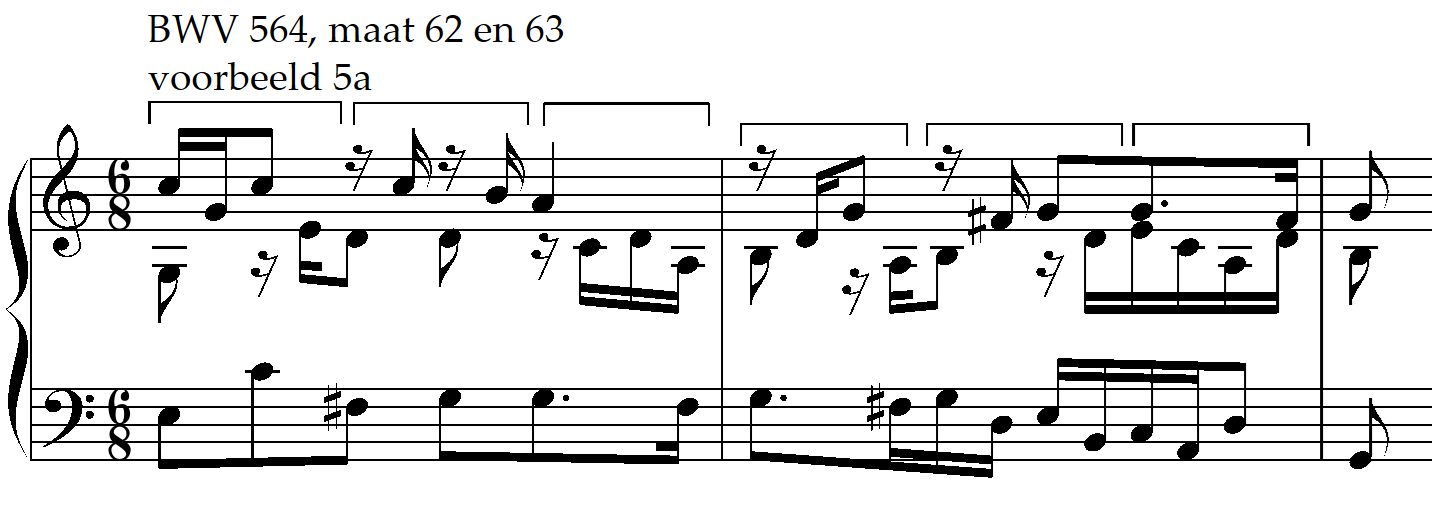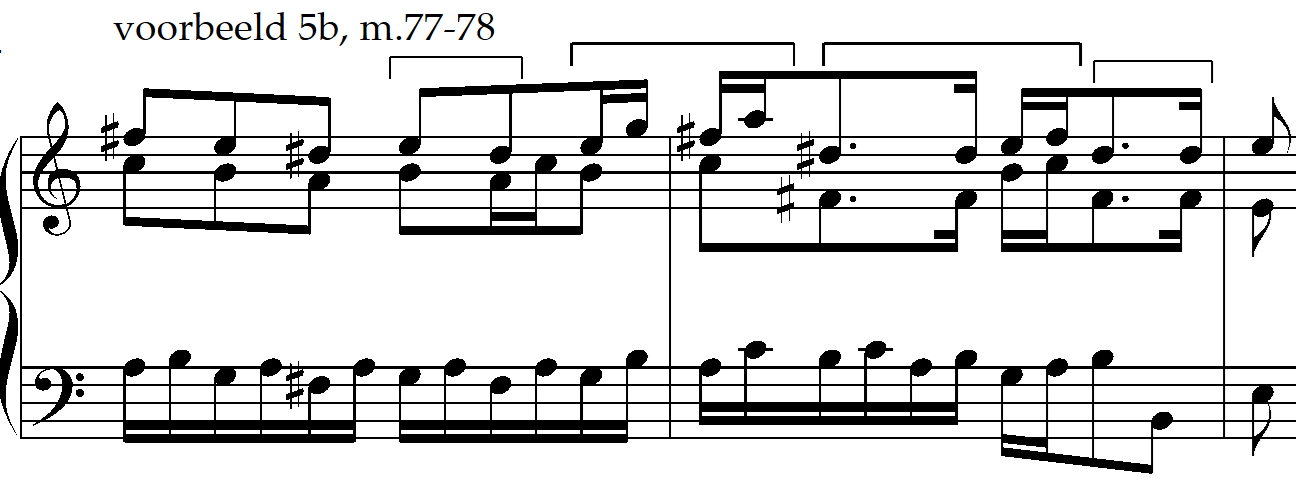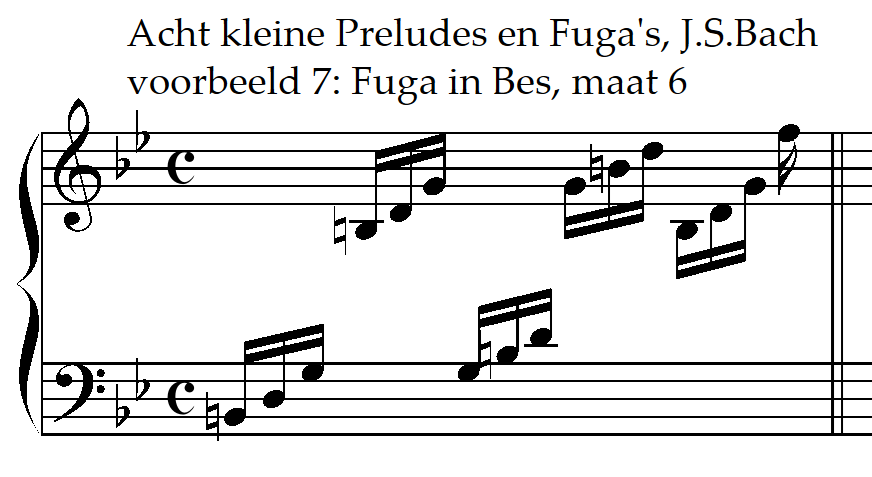Shifting accents in triple metre with Bach

Menuet uit Partita in G, BWV 829
Is this really a minuet? After all, we hear a six-eighth bar, unexpectedly concluded with a cadence in three-quarter time. The division of the hand, in which the right hand always plays the first of three notes, inevitably results in a division of the bar into two groups of three notes. Bach plays a fascinating game with our rhythmic perception here, and he does so not only here.
Introduction
Classical music is usually notated in regular time signatures. Yet, on closer inspection, the accentuation sometimes deviates from that regularity. The harmonic pulse can change from half to whole bars, sometimes even per four bars for short bars. In three-part time signatures there are more possibilities for irregular accentuation that composers like to use. They can choose to change the signature from triple meter to duble meter at certain times. Instead of the normal division of, for example, a 6/4 bar into two times three notes (123.456), the division becomes three times two notes (12.34.56). This creates an interesting shift in emphasis that is already used in old Spanish music:
 (P.Bruna (1611-1679), Tiento de primer Tono)
(P.Bruna (1611-1679), Tiento de primer Tono)
But this is also used in later music. With Franck we find it in the Pastorale:

And with Vierne in the Scherzo from the 2nd Symphony:
![]()
Examples in Bach's music
Quarter notes
Just as in Franck's Pastorale, we regularly find this hemiola in cadences in Baroque music.1. Het duidelijkst is dat genoteerd aan het slot van de fuga in e klein uit de acht kleine Preludes en Fuga’s (BWV 555). De maatsoort wijzigt aan het slot van ¾ naar 3/2. In feite gaat de ‘tel’ dus twee keer zo langzaam (example 4a).
In de meeste andere werken wordt dat niet zo duidelijk genoteerd en moeten we op dergelijke plaatsen twee maten samenvoegen, zoals in maat 13 en 14 van het Preludium in F (BWV 556, no. 4 from the same collection), where instead of two times three eighths in fact a three-quarter bar is created that is divided over two bars (example 4b).

Eight notes
Sometimes the classification is not immediately clear from the notation. At first glance it looks regular, but to a listener it may sound different or be ambiguous. That may also be the composer's intention, but as performers we have to play along in that game. Sometimes we have no choice but to go along with the sounding accentuation, even if it (temporarily) goes against the underlying time signature, as in the Minuet at the top of this article. zoals bij het Menuet bovenaan dit artikel.
It is important to understand the harmonic coherence in such passages in order to make the correct rhythmical relation and not to obstruct the flow of the music.
In Bach's Toccata, Adagio and Fugue in C (BWV 564) almost all cadences are hemiolas, as is already the case in the last measure of the theme. In bars 62 and 63, even two bars in succession can be interpreted as hemiolas:

But sometimes Bach's imagination goes further and he varies the rhythmical division, as with the cadence in example 5b. voorbeeld 5b. It is an important place in this fugue because the pedal will be silent for a long time after this and in addition - for a work in C major - the less common key of E minor is prepared. It almost seems like a mistake that the dominant already falls on the second eighth of bar 78, which would cause the tonic to come out half a bar too early. By repeating the same formula again, the accent ends up on the first beat of the next measure. Bach plays a clever game here with our expectation of hearing an ordinary hemiola, by unexpectedly adding a half bar and shifting the accent again:

Just before the last theme-entry, from bar 120, a situation arises that is full of ambivalent hemiola-like divisions. The notation for the right hand, with many rests and, at first glance, an irregular placement of the eighth notes, can be read as ‘fake’ polyphony. Written in unison and in continuous semiquavers, it looks clearer.
Example 5c1 already provides a logical layout due to the adjusted placement of the beams:

But when the left hand - the bass and therefore the harmony - is involved, it turns out to be intended differently.
The hemiolas then do not appear to be continuous (the brackets above the notes in example 5c2), but to be interrupted by a group of three eighth notes. Or is it possible that in measures 120 and 121 it is still different, continuous (such as the brackets under the notes in 5c2), thus deviating from example 5c1?

In example 5c2, the notation for the right hand is notated in sixteenths, with the eighths from Bach's notation indicated with small slurs, which indicate the notated over-legato. Interestingly, from the middle of measure 121 onwards this over-legato is reinforced: Bach notes eighth notes with a dot there to indicate the prolongation. This causes a density in sound towards the end, which, in addition to the play with rhythm, also uses the way of playing to give this passage more expression.
Sixteenth notes
Bach also plays with the possibility of shifting accents in passages with continuous fast figuration. A rather exceptional example (although not unique) is found in the fourth sonata for violin and harpsichord:

Here, the articulation slurs create groups of three notes, which for two bars run against the rhythmic division of the underlying time signature. Due to this bowing, it is not possible for a violinist to play the notation per four sixteenths; this inevitably produces counter-accents per three.
Homophonic passages lend themselves well to such shifts, which are not always easy to recognize without articulation slurs, but they do indeed cause an audible shift in emphasis.
A clear example can be found at the end of the fugue in D minor BWV 539, originally for violin (BWV 1001, part 2).
68th notes are notedth unusually fast notes at that time. The 24 notes are arranged as 3 times 8, but due to the speed they inevitably sound like 8 groups of 3:

In the same work, although there are no slurs in the organ version, this division also applies to m.82, in accordance with m.79 from the violin version:

A well-known example for organists, in which the player follows the division almost automatically, is found in the last Prelude from the eight small Preludes and Fugues (no. 8 in B flat major, BWV 560). The division of this bar (6+6+4 notes) can be clarified during performance by holding the bass note of each group a little longer (as over-legato):

The issue becomes particularly interesting if we compare some of Bach's pieces that contain passages that can be read in different ways. By making a different division, counter-accents are created, which through their regular sequence form a new rhythmic relationship. It offers, as it were, a rhythmic counterpoint that overlays the original time signature (as we already saw with the Fugue in C, BWV 564). It temporarily distracts from the prevailing sense of time, which as soon as it is restored is recognized and welcomed by the listener, as in the Prelude in G major (the next example) where it is followed by a triumphant motif in the pedal that reaffirms the ¾ time.
In this Prelude in G major (BWV 541), the rhythmic division at the end of the unison introduction is different than the time signature suggests. After two bars in which hemiolas are created, this solo ends with an ascending triad motif that, according to the notation, produces illogical accents. However, if it is understood with a division by three notes, by analogy with the passages in example 6 and especially the minuet at the beginning of this article, a more logical picture emerges:

As in the Minuet from the Partita in G, the right hand could take the first of the three notes, the left hand the next two.
In the first Sonata for solo violin (BWV 1001) we find a similar passage, now with a descending triad motif. Even in a 'modern' smooth version, the ear involuntarily creates a division per three notes. In a 'baroque' performance, where the player also wants to express the rhythmic division, a choice must be made: accents on the first and fourth notes, or on the first and fifth notes, because that division can also be defended musically here:

Later in this movement, Bach supports the normal 3/8 division with articulation slurs per 2 notes. But sometimes this is suddenly broken with surprising groupings such as in bars 33-35:

Even in keyboard music without articulation slurs, such irregular divisions can be found, which are worth making audible with a nuanced accentuation.
In the first part of the Fantasia in G BWV 572 we are faced with the same question again: when is the division in eighths and when in three-sixteenths?
The division of the first measure is clear, but already in the second measure the sixteenth notes are grouped by three. Presumably, however, this division was made to indicate the division of the notes between the left and right hand. Because also in the second bar the continuation of the division from the first bar is the most logical. In the note example, additional semiquaver flags on the first and third eighth of each figure indicate which notes play the harmonically leading role, in line with the first bar (an accent on the fourth sixteenth of bar 2 would emphasize a 6/4 position of the chord, unusual in this context):

However, it is not always clear which division is intended. Sometimes the division per three sixteenths is so aurally compelling to the ear that, for example, in bar 25 we will still opt for a division per three notes, and may therefore, on further reflection, decide to apply this in other bars as well.

There is no clear solution everywhere for the grouping of the sixteenths in this unison passage. But it is clear that not every possibility for a different division can be used to change the accent.
Finally, a side trip to the music of Buxtehude, to show how easily misunderstandings can arise around this rhythmic issue. The most famous 'error' in the organ repertoire with regard to this issue can be found in Buxtehude's Prelude in G minor.
There are two sources of this work, both of which follow the regular division of sixteenths per eighth note. An edition or an interpretation that suggests triplets here, which occurs regularly, is therefore wrong.
But it soon becomes apparent that the three-note division is so strong that it takes over aurally. It is difficult to emphasize the division by eighth in the way of playing (unless it is played quite slowly, which is not obvious in such a passage). Moreover, a few bars later the intention seems to be to introduce a change between groups of two and three sixteenth notes (bars 7 and 8).
Apparently the accentuation varies and a strictly intended performance per two or three sixteenths will be difficult for the audience to distinguish.

Conclusion
Just as a violinist sometimes finds prescribed articulations in music but often has to decide which bowing to use and how the accentuation should be expressed, the organist is also faced with the question of which rhythmic interpretation would best suit the notes. If we are aware of this, we will have to make choices in this regularly occurring ambivalence of the rhythmic division, because random smooth playing does not do justice to these beautiful compositional details.
Reitze Smits
(published in Het Orgel in 2022, (revised version 2025)
1 footnote Hemiola: two groups of three divided as three groups of two.